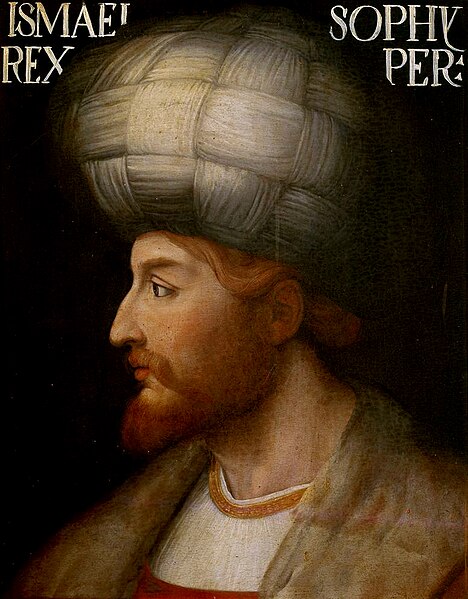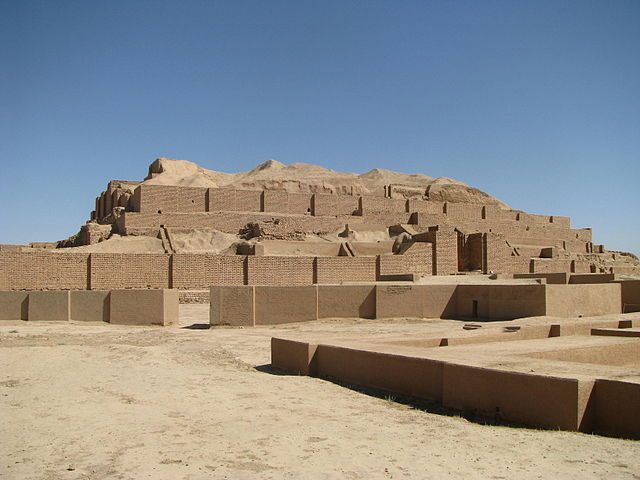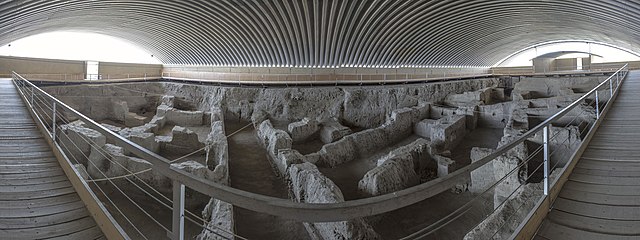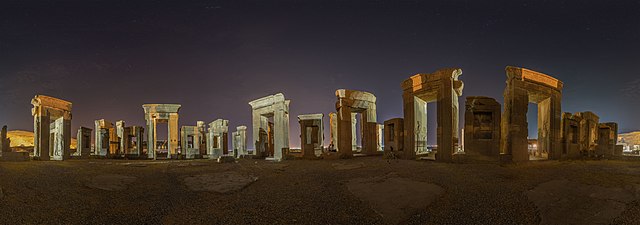Safavid Iran or Safavid Persia, also referred to as the Safavid Empire, was one of the largest and long-standing Iranian empires after the 7th-century Muslim conquest of Persia, which was ruled from 1501 to 1736 by the Safavid dynasty. It is often considered the beginning of modern Iranian history, as well as one of the gunpowder empires. The Safavid Shāh Ismā'īl I established the Twelver denomination of Shīʿa Islam as the official religion of the empire, marking one of the most important turning points in the history of Islam.
Mannequin of a Safavid Qizilbash soldier, showing characteristic red cap (Sa'dabad Palace, Teheran)
Ismail declares himself "Shah" by entering Tabriz; his troops in front of Arg of Tabriz, painter Chingiz Mehbaliyev, in private collection.
One of the first actions performed by Shāh Ismā'īl I of the Safavid dynasty was the proclamation of the Twelver denomination of Shīʿa Islam as the official religion of his newly-founded Persian Empire, causing sectarian tensions in the Middle East when he destroyed the tombs of the Abbasid caliphs, the Sunnī Imam Abū Ḥanīfa al-Nuʿmān, and the Ṣūfī Muslim ascetic ʿAbdul Qādir Gīlānī in 1508.
Ismail's battle with Uzbek warlord Muhammad Shaybani Khan in 1510, on a folio from the Kebir Musaver Silsilname. After the battle Ismail purportedly gilded the skull of Shaybani Khan for use as a wine goblet.
Iran, also known as Persia and officially the Islamic Republic of Iran (IRI), is a country in West Asia. It is bordered by Iraq to the west and Turkey to the northwest, Azerbaijan, Armenia, the Caspian Sea and Turkmenistan to the north, Afghanistan to the east, Pakistan to the southeast, the Gulf of Oman and the Persian Gulf to the south. With a mostly Persian-ethnic population of almost 90 million in an area of 1,648,195 km2, Iran ranks 17th globally in both geographic size and population. It is the sixth-largest country entirely in Asia, the second-largest in West Asia, and one of the world's most mountainous countries. Officially an Islamic republic, Iran has a Muslim-majority population. The country is divided into five regions with 31 provinces. The nation's capital and most populous city is Tehran, with around 16 million people in its metropolitan area. Other major cities include Mashhad, Isfahan, Karaj, and Shiraz.

The well-preserved Inscription of Ardashir Babakan (224–242 AD) in Naqsh-e Rostam: "This is the figure of Mazdaworshipper, the lord Ardashir, King of Iran."
Chogha Zanbil (14th-13th century BC), an ancient Elamite complex in Khuzestan, built by Untash-Napirisha. UNESCO World Heritage Site.
Ecbatana (present-day Hamadan) was chosen as the first capital of Iran by Deioces in 678 BC, the founder of Medes Empire.
Persepolis, the ceremonial capital of the Achaemenid Empire (550–330 BC). It is one of the key Iranian Cultural Heritages.








